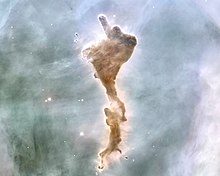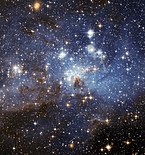Bok globule
| Bok globule | |
|---|---|
 The Finger of God Globule in the Carina Nebula | |
| Characteristics | |
| Type | Isolated Dark nebulae |
| Found | HII regions |
| Mass range | 2M☉-50M☉ |
| Chemical composition | Molecular hydrogen, carbon oxides, helium, and silicate dust |
| Size range | ~1ly |
| External links | |
| Additional Information | |
| Discovered | Bart Bok, 1940s |
| Star formation |
|---|
 |
| Object classes |
| Theoretical concepts |
In astronomy, Bok globules are isolated and relatively small dark nebulae containing dense cosmic dust and gas from which star formation may take place. Bok globules are found within H II regions, and typically have a mass of about 2[1] to 50 solar masses contained within a region about a light year or so across (about 4.5×1047 m3).[2] They contain molecular hydrogen (H2), carbon oxides and helium, and around 1% (by mass) silicate dust. Bok globules most commonly result in the formation of double- or multiple-star systems.[3]
History
[edit]Bok globules were first observed by astronomer Bart Bok in the 1940s. In an article published in 1947, he and Edith F. Reilly hypothesized that these clouds were "similar to insect's cocoons" that were undergoing gravitational collapse to form new stars, from which stars and star clusters were born.[4][failed verification] This hypothesis was difficult to verify due to the observational difficulties of establishing what was happening inside a dense dark cloud that obscured all visible light emitted from within it. An analysis of near-infrared observations published in 1990 confirmed that stars were being born inside Bok globules.[5] Further observations have revealed that some Bok globules contain embedded warm sources,[2] some contain Herbig–Haro objects,[6] and some show outflows of molecular gas.[7] Millimeter-wave emission line studies have provided evidence for the infall of material onto an accreting protostar.[8] It is now thought that a typical Bok globule contains about 10 solar masses of material in a region about a light-year or so across, and that Bok globules most commonly result in the formation of double- or multiple-star systems.[5][9][10]
Bok globules are still a subject of intense research. Known to be some of the coldest objects in the natural universe, their structure and density remains somewhat a mystery. Methods applied so far have relied on column density derived from near-infrared extinction and even star counting in a bid to probe these objects further.
Bok globules that are irradiated by ultraviolet light from hot nearby stars exhibit stripping of materials to produce a tail. These types are called "cometary globules" (CG).[11]
Image gallery
[edit]-
Thackeray's Globules, a set of Bok globules in the H II region IC 2944, taken with the WFPC2 instrument on the Hubble Space Telescope
-
Bok globules located within the NGC 281 nebula (IC 1590 cluster)
-
Barnard 68, at a distance of only 410 light-years, is one of the nearest Bok globules. Its diameter is about 12,500 AU (0.198 ly) (≈ 2 trillion km)
See also
[edit]References
[edit]- ^ Michael Szpir (May–June 2001). "Bart Bok's Black Blobs". American Scientist. Archived from the original on 2017-04-24. Retrieved 2008-11-19.
Bok globules such as Barnard 68 are only about half a light-year across and weigh in at about two solar masses
- ^ a b Clemens, Dan P.; Yun, João Lin; Meyer, Mark H. (March 1991). "BOK globules and small molecular clouds – Deep IRAS photometry and (C-12)O spectroscopy". Astrophysical Journal Supplement. 75: 877. Bibcode:1991ApJS...75..877C. doi:10.1086/191552.
- ^ Launhardt, R.; Sargent, A. I.; Henning, T.; Zylka, R.; Zinnecker, H. (10–15 April 2000). "Binary and multiple star formation in Bok globules". Birth and Evolution of Binary Stars, Poster Proceedings of IAU Symposium No. 200 on The Formation of Binary Stars. Potsdam, Germany: Bo Reipurth and Hans Zinnecker. p. 103. Bibcode:2000IAUS..200P.103L.
- ^ Bok, Bart J.; Reilly, Edith F. (March 1947). "Small Dark Nebulae". Astrophysical Journal. 105: 255. Bibcode:1947ApJ...105..255B. doi:10.1086/144901.
- ^ a b Yun, João Lin; Clemens, Dan P. (December 20, 1990). "Star formation in small globules – Bart Bok was correct". Astrophysical Journal Letters. 365: L73. Bibcode:1990ApJ...365L..73Y. doi:10.1086/185891.
- ^ Reipurth, Bo; Heathcote, Steve; Vrba, Frederick (March 1992). "Star formation in Bok globules and low-mass clouds. IV – Herbig–Haro objects in B335". Astronomy & Astrophysics. 256 (1): 225. Bibcode:1992A&A...256..225R.
- ^ Yun, João Lin; Clemens, Dan P. (January 1992). "Discovery of outflows from young stellar objects in BOK globules". Astrophysical Journal Letters. 385: L21. Bibcode:1992ApJ...385L..21Y. doi:10.1086/186268.
- ^ Zhou, Shudong; Evans, Neal J. II; Koempe, Carsten; Walmsley, C. M. (March 1993). "Evidence for protostellar collapse in B335". Astrophysical Journal, Part 1. 404 (1): 232. Bibcode:1993ApJ...404..232Z. doi:10.1086/172271. S2CID 120834998.
- ^ Clemens, D. P.; Yun, J. L.; Heyer, M. H. (1991). "Bok globules and small molecular clouds—Deep IRAS photometry and (C-12)O spectroscopy". Astrophysical Journal Supplement. 75: 877–904. Bibcode:1991ApJS...75..877C. doi:10.1086/191552.
- ^ Launhardt, R.; Sargent, A. I.; Henning, T.; Zylka, R.; Zinnecker, H. (2000). "Binary and multiple star formation in Bok globules". In Reipurth, B.; Zinnecker, H. (eds.). Birth and Evolution of Binary Stars, Poster Proceedings of IAU Symposium No. 200 on The Formation of Binary Stars. p. 103. Bibcode:2000IAUS..200P.103L.
- ^ Cometary globules. 1 Formation, evolution and morphology, B. Lefloch and B. Lazareff, 1994.




